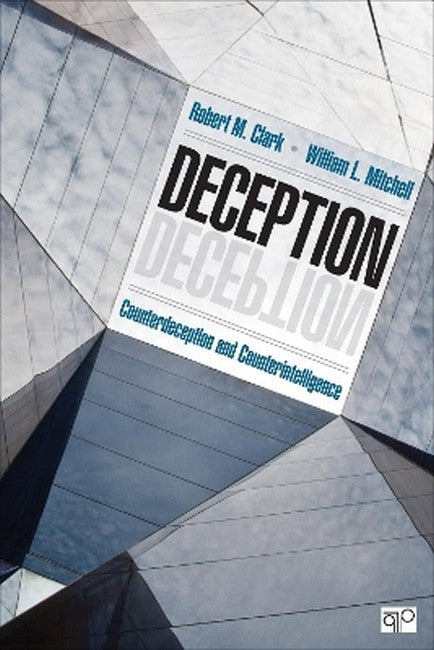Robert M. Clark has more than five decades of U.S. intelligence community experience. A USAF lieutenant colonel (retired), Dr. Clark served as an electronics warfare officer and intelligence officer. At the CIA, he was a senior analyst and group chief responsible for developing analytic methodologies. He was cofounder and CEO of the Scientific and Technical Analysis Corporation, a privately held company serving the U.S. intelligence community. Clark holds an SB from MIT, a PhD in electrical engineering from the University of Illinois, and a JD from George Washington University. Beyond analyzing wicked intelligence issues, his passion is writing on the topic of intelligence. His books include Intelligence Analysis: A Target-Centric Approach (5th edition, 2016), The Technical Collection of Intelligence (2010), and Intelligence Collection (2014). He is coauthor, with Dr. William Mitchell, of Target-Centric Network Modeling (2015) and Deception: Counterdeception and Counterintelligence (2019); and coeditor, with Dr. Mark Lowenthal, of Intelligence Collection: The Five Disciplines (2015). Dr. Clark also develops and teaches courses for audiences in academia, national intelligence, and the military. He currently serves as an adjunct professor at the Johns Hopkins University teaching graduate courses. William L. Mitchell's military and intelligence career spans three decades including operations in Afghanistan, the Balkans, Iraq, Africa, and French Guyana. Dr. Mitchell is currently an active member of Danish Defence and an all-source specialist, researcher, instructor, and lecturer. At the Royal Danish Defence College (RDDC) he is responsible for the synchronization of theory, practice, and education regarding intelligence and joint operations. He is a member of the RDDC Research Board and supports NATO and US Department of Defense research, education, and doctrine development programs. He has several publications on intelligence and battlespace agility, and was part of the NATO Science & Technology Organization group awarded the 2014 NATO Scientific Achievement Award. Dr. Mitchell has a BA, an MA with Distinction from Kent University, and a PhD from Aarhus University in Political Science. He is a decorated war veteran of two countries, with one citation and several medals, including the French Croix de Combatant and the Danish Defence medal.
Request Academic Copy
Please copy the ISBN for submitting review copy form
Description
List of Tables, Figures, and Boxes Preface About the Authors PART I: FUNDAMENTALS OF DECEPTION AND COUNTERDECEPTION Chatper 1: Deception: The Basics Why Deception? Definitions The Deception Target Basic Principles Roles of Operations and Intelligence Chapter 2: The Methodology The OODA Loop OODA Loop Perspectives Planning Deception: The Inverse OODA Loop Executing Deception: The Forward OODA Loop Chapter 3: The Outcome Scenario Outcome Scenarios - The PMESII View Political Military Economic Social Information Infrastructure Chapter 4: The Target Individual Decision Modeling Collective Decision Modeling Cultural Modeling Chapter 5: The Story What Makes a Good Story? Characteristics of a Good Deception Story Plausibility Reinforcement Influence Nets Chapter 6: The Channels Understanding the Channels Sensor Mapping Channel Characterization Channel Exploitation Chapter 7: The Traditional Intelligence Channels OSINT COMINT HUMINT IMINT Technical Collection Chapter 8: The Cyberspace Channel Deception in Cyberspace Web-Based Deception Web-Based CNE/CNA Standalone Computers and Intranets Cyber Deception Chapter 9: Planning and Executing Deception Checking the Decision/Action Model: Red Team Analysis Checking for Unfavorable Outcomes: Alternative Analysis Deconfliction Overview of the Execution Process Achieving Surprise Operating Inside the Opponent's OODA Loop Attending to Details and Timing Managing the Developing Scenario Chapter 10: Preparing to Counter Deception Assessing Vulnerability Assessing the Threat Chapter 11: Identifying Deception Deception Detection via Channel Management Evaluating the Source Evaluating the Channel Evaluating the Evidence PART II: EXERCISES Chapter 12: Sensor Mapping and Channel Tracking Exercises Sensor Mapping Exercises Channel Management Exercises - Deception Projection Chapter 13: General Deception Planning Exercises Exercise 1: Derailing a Trade Negotiation Exercise 2: Protecting Drug Cartel Shipments Exercise 3: Taking Down the Fordow Uranium Enrichment Facility Exercise 4: Countering Israeli Efforts to Take Down Fordow Exercise 5: Supporting a NEO Evacuation Exercise 6: Disrupting Boko Haram Operations Chapter 14: Military Deception Planning Exercises MILDEC CONOP Example: Operation Bulldozer Exercise 1: Operation Lights Out Exercise 2: Operation Timber Float Exercise 3: Operation Closing Time Chapter 15: Deception Detection Exercises Exercise 1 - The Valley of Doubt Exercise 2 - The YUTA Ghost Bibliography Index
"The chapters on the exercises are a treasure chest of material to work with, covering a whole array of scenarios. . . . I think virtually every page and topic could spark robust and spirited classroom discussion starting with the text title itself." -- Ronald W. Vardy "Most students have very little or no background [in this subject area], so Clark's work is great to introduce students to intelligence and the analytical disciplines . . . a really excellent book that fills a gaping hole in the public literature and is of genuinely great value to both students and practitioners." -- Carl A. Wege, Professor Emeritus

